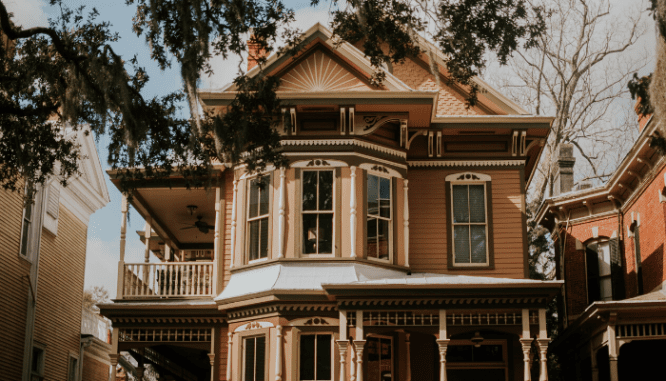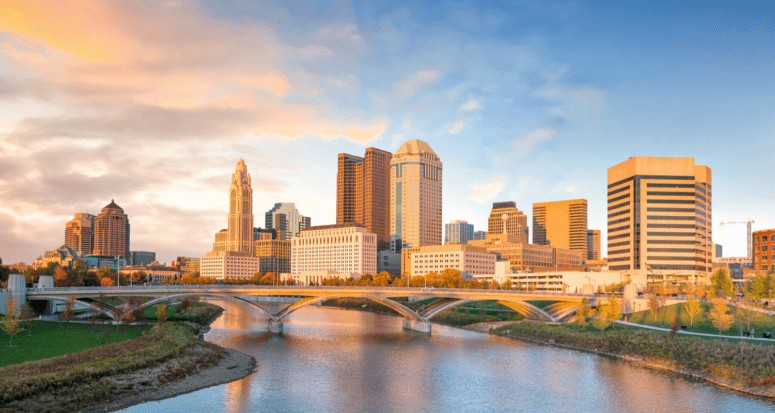The Insider’s Guide to Buying a House in Columbus, Ohio (Go Buckeyes!)
- Published on
- 6 min read
-
 Mary Beth Eastman Contributing AuthorClose
Mary Beth Eastman Contributing AuthorClose Mary Beth Eastman Contributing Author
Mary Beth Eastman Contributing AuthorMary Beth Eastman is an award-winning journalist and writer. She adores old houses—hers is a 1920 foursquare with decent bones—and is passionate about helping people make smart investments in real estate.
Believe it or not, Columbus, Ohio, is one of the hottest real estate markets in the nation, even reaching the No. 1 “hot real estate market” spot in April 2019. That’s because more and more buyers in Ohio’s capital city are taking advantage of its strong job growth, low cost of living, and affordable housing stock.
One of the few Rust Belt cities that’s growing at a quick clip — almost 900,000 people called Columbus home in 2019 — this city saw more than 300,000 new neighbors move in from 2014 through 2017. In fact, it was the only Midwest city to make the top 10 list of fastest-growing cities identified by the U.S. Census bureau in May 2019.
As a result, you’ll have to have your checkbook ready if you’re serious about settling down here, because homes move fast, especially ones that are affordably priced. (In fact, backyard deals mean some homes for sale never even make it on the MLS.)
To make sure you can still get into a home you love (without paying an arm and a leg), we’ve interviewed experts with decades of Columbus-specific experience and knowledge of every neighborhood to break down exactly what you need to know before you buy. You won’t overpay, and you’ll be right at home at the heart of it all.

Start with the average price of a Columbus home
The number one thing you’ll have to prepare for is a lot of competition. With the market sizzling at the lower price points, buyers will need to stay on their toes. “It’s a seller’s market until you start looking at homes over $600,000,” says Dan Fenters, an agent with 19 years of experience in the Columbus metro area.
To give you a better idea of how homes are priced around Columbus, here are some stats: The average home sold for $239,729 in October 2019, with a median price of $205,000, according to Columbus Realtors. Compare that to the nationwide median home price of $285,700 (as of June 2019), and you can see that Columbus houses are a relative steal. With many U.S. housing markets in an affordability crunch, it’s easy to understand what makes these homes so attractive — having money left over after you pay your mortgage sounds good to us, too!
You can also compare Columbus-area housing prices with the typical rent: the U.S. Census puts Columbus median rent at $975 per month, although more recent data shows rents tripping the $1,000 mark. As such, rent ($1,105) and a typical mortgage on a $250,000 home ($1,336, assuming a 20% down payment) are both in the same ballpark. That means more than half of the metro area’s renters can afford to buy if they choose.
Figuring out your budget
So what will a moderate budget get you here? Central Ohio’s sprawling flat landscape means there’s room to spread out, so it’s easier than other places to get into a roomier home in terms of sheer square footage. With a median price per square foot of $120, that means homes under $250,000 can easily gain you more than 2,000 square feet of living space.
But of course, it depends on location, with hot neighborhoods easily costing twice that. Getting into a home in the desirable German Village, for example, will cost an average of $432,000, with an average price per square foot of $297 (as of January 2020).
On the other hand, a German Village home is poised to appreciate considerably. As Fenters reminds buyers: “You’re looking at 5% to 7%” appreciation in the hotter markets. “It’s pretty darn high.” And you’ll need to stay for just a couple of years to see that sort of return on your investment, he said.
If your budget is tight
If you need to keep the price low, look for tradeoffs: fewer bedrooms, for example, or a location that’s further out from restaurants and shopping. And consider your emotional attachment to the home.
A well-staged house feels cozy as soon as you walk in, and that often translates to higher asking prices, according to professional stager Lindsey Riemenschneider. She’s owned C&B Staging in Columbus, a firm with solid 5-star reviews on Yelp, for six years.
According to Riemenschneider, there are ways the current trend in staging can work to a buyer’s advantage. For instance, lots of buyers like to see homes that “look as though Joanna and Chip [Gaines, of HGTV] just left the house.” But if a home you’re considering hasn’t been nicely staged or decluttered, other buyers may pass on even looking at it.
If you can look beyond disappointing listing photos, you just might find a gem you can put your own finishing touches on. Plus, if a seller isn’t competitive on staging the home, there may be room for you to push back on remediations when you are at the contract negotiation stage. This could be especially useful on older homes that might need a little more work.
If you’re still unsure how much home you can afford, use HomeLight’s simple home affordability calculator to figure it out. Having a target price makes narrowing down possibilities way easier.
Your taxes
Don’t forget to account for your tax liability. In Columbus, real estate is assessed at 3.5% of the home’s value, and owner-occupied homes get a tax reduction. You can expect to pay at least $2,100 in taxes on a $100,000 home in the city. For communities with highly rated schools, there is a tax tradeoff. If you live in Upper Arlington, which is known for its schools, taxes on a $100,000 home would be $2,427; in Westerville, they would be $2,716.
Insurance risks
Even though Columbus is land-locked, you’ll still need to make sure your home isn’t on a FEMA flood plain. Jeff Clark, principal at Buckeye Appraising, Inc., notes that there are several areas within Columbus that are classified within a FEMA floodplain. “Most of these are small pocket areas,” he says. Look for these near the Scioto and Olentangy rivers, which run north to south through Columbus and affecting nearby suburbs.
As a buyer, your biggest concern about being in a FEMA floodplain is the cost of home insurance, said Clark, “which can be several hundred or even thousands of dollars more per year.” Buckeye Appraising, the only appraisal firm in Central Ohio with a Torch Award for Ethics from the Better Business Bureau, “has observed many ‘bidding wars’ for homes on the market,” Clark said.
As you’re keeping future insurance costs in mind, also be aware that homes may go under contract well above the asking price. If your appraisal is low, there may be a clause in the contract requiring an additional amount to be paid out-of-pocket.

What kinds of homes can you buy in Columbus?
Looking for a single-family home? They’re quite popular in central Ohio. Since Columbus was founded in 1812, its existing homes span the American architectural timeline:
Victorian and Queen Anne
You’ll find these storybook houses in the aptly-named Victorian Village, near the campus of The Ohio State University and Children’s Hospital, as well as elsewhere in the older areas of the city and the older areas of surrounding suburbs. Updated Victorians are very desirable — and very expensive. But nothing beats them for charm!
Fenters recommends you make sure you have these homes tested for radon. You may be able to negotiate with the seller on remediation if it doesn’t pass the test.
Craftsman and Foursquare
These home types sprang up after the turn of the century and were very popular during the 1920s. With these homes, it’s key to check the electrical systems — knob-and-tube wiring can still be found in houses that haven’t been updated, and you’ll probably need to invest in a quality electrician. Hire a structural engineer to make sure your inspection is thorough and covers the sort of foundation issues 100-year-old homes may have.
In an area with mature trees, look for possible insect infestations or even a stray raccoon in the attic. Towering old oaks and maples are a treasure, but they also offer a highway directly onto the roof for rodents and other pests.
Cape Cod and ranch
Post-war houses built in the 1940s and 1950s are often two- or three-bedroom cottages. They might offer less square footage than the modern home shopper is looking for, so check for homes that have been added onto as a way to win extra living space.
You can find quaint 1960s ranch homes in the suburbs ringing Columbus, from Bexley on the east to Grove City on the west. As a plus, many ranches are clustered together in neighborhoods with gently winding streets, cutting down on noise and traffic.
Your No. 1 priority with homes of this era is checking the foundation for cracks and making sure the electrical system can handle modern living. If the price of the home is high and you’ll have to pay dearly to bring it into the 21st century, grit your teeth and walk away from the deal — or know you may not recoup that investment if you need to sell in a few years.
Split-level and New Colonial
Beginning in the ’70s and ’80s and continuing into the 1990s, these home styles enjoyed a brief but fervent popularity, so you’ll see a lot of them in neighborhoods built around then. The families who enjoyed these housing plans have grown up, and the second generation of homeowners have rediscovered the appeal of two-story (or one-and-a-half story) living.
With homes of this style and age, you need to make sure that the fundamentals have been replaced and properly cared for, including checking the age of the roof and HVAC systems. Updated kitchens and baths are a must, too (and shag carpet is a definite red flag). On the other hand, since these homes aren’t too terribly old, doing some updates yourself won’t need to involve the Register of Historic Places.
New builds
One way to get into a new home in Columbus is the tear-down: buying an old home, knocking it down, and putting a new build on the lot. You might see this happening in the more desirable suburbs. Or, other buyers take the existing old home down to the studs and build it back up according to code. This gives you the advantage of a desirable location without the heartache of a money-pit older house, plus it eliminates the high costs of a new foundation and framing.
There have also been plenty of new-construction developments as well — but if you have an eye toward moving in a few years, it pays to consider whether the area you’re looking in has a decent resell potential. New builds and condos may not hold on to their value the way a trendy neighborhood will.

Get the lay of the land in Columbus
Picture a steering wheel: that’s I-270, the beltway surrounding Columbus. At 10 and 2 you’ll have Dublin and Westerville, respectively; two suburbs with attractive schools. In the center, where your horne would be, is the city of Columbus, with a few main arteries traveling north-south.
The first main artery is I-71, which leads from Cleveland in the north to Cincinnati in the South. The next is U.S. 23, which cuts straight through the University District of The Ohio State University and brings you right into the heart of downtown. And the last route to know is Ohio 315, which connects the popular neighborhoods of Powell, Clintonville, Upper Arlington and Grandview Heights with the university.
Although walkable towns are increasingly popular with homebuyers, Columbus is still very much a driving city, and traffic can be beastly — especially at rush hour. Knowing how to skirt construction (a constant on Ohio highways) means knowing where you are in relation to the expressways and the back-roads shortcuts.
So where do you want to be? Take a look at some popular neighborhoods:
Downtown
Looking to downsize, or love condo living? Check out Downtown. Condos here can be slightly oversupplied, according to Fenter, so you could get a good deal. Plus, you’re right at the heart of it all: take in a Blue Jackets NHL game at Nationwide Arena, or visit the Columbus Museum of Art. If you snag (highly coveted) tickets to an OSU Buckeyes football game, you’re just minutes away from the “Horseshoe,” the Buckeyes’ iconic stadium.
Short North
Just north of Downtown is the Short North Arts District, an area with top-notch dining and restaurants. This area is a draw for Columbus residents in general and tourists, too. Just to the west is the Victorian Village, full of pre-1900 architecture and a short hop to the University. Living here means gallery hops, open-mic nights and some of the city’s best food: Pick up a fire-baked bagel at Lox Bagel Shop while house-hunting, and you’ll see what we mean.
Clintonville
North of the University, along High Street (U.S. 23) and bounded by the Olentangy River, is chill, walkable Clintonville. As demand here increases, older homes are being updated and sold at higher prices, and prices can be expected to continue to appreciate as demand increases. Many couples buy their starter homes in Clintonville and move when their families expand.
Dublin, Powell, and the northern suburbs
If you’d like to spread out a little bit or are looking for a little more space, check out the northern suburbs. In Powell, for example, you’ll find lots of green space, bike paths and parks — perfect for the dog-lover. In Dublin, which was settled by Irish immigrants nearly two centuries ago, you’ve got to check out the Pedestrian Bridge: 169 feet high and spanning the Scioto River.
German Village and the Brewery District
Just south of Downtown is German Village and the Brewery District, both trendy neighborhoods where homes are appreciating rapidly. Houses here trade fast and at a premium, but the location is a knockout: the brick homes, brick sidewalks, brick everything give German Village a sense of pride in its community and a look that charms pretty much everyone.
For condominiums, consider the Brewery District: Not too many families settle down here, but thanks to the area’s recent redevelopment you’ll find upscale loft apartments as well as terrific dining and entertainment options.
Though prices may be higher in the trendier districts, the taxes are lower, and these homes are typically easy to resell, Fenters says.

Best time to buy in Columbus
If you’re looking for a fast close, the best time to buy in Columbus is September, when homes are on the market for just 22 days. But if you want to save on the home price, January is your best bet: Homes sold in January sold for 16% lower than average. That means you may want to start your house hunting in the fall to account for the time it takes to get to closing. If you’re shopping in the spring and summer, expect to see more activity and higher prices.
You can use our “Best Time to Sell” tool to see actionable data for your particular timetable.
Find a top buyer’s agent in Columbus
House-hunting can be a roller coaster. “Sometimes people get emotional about homes, obviously, and they’re willing to way overpay,” Fenters said, making “crazy, crazy offers.”
Avoid overpaying in a seller’s market by making sure you have a reliable real estate agent by your side — someone who knows the market well and will work to find the right home at the right price. A good agent can also help you connect with professionals so you can get preapproval or pre-underwriting, qualified inspections, and realistic appraisals.
The best agent can read the market data and save you thousands on the right home, so you can rest assured you’ve paid the right place for your new house.
Header Image Source: (f11photo / Shutterstock)

